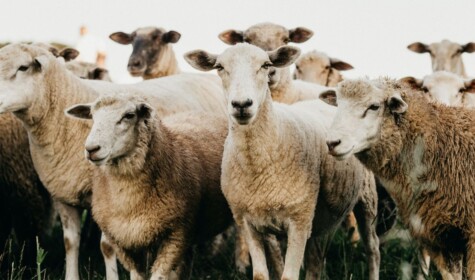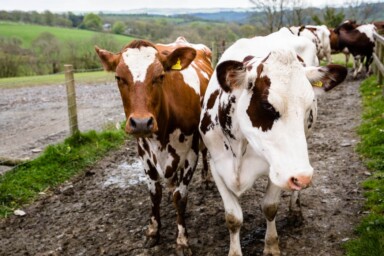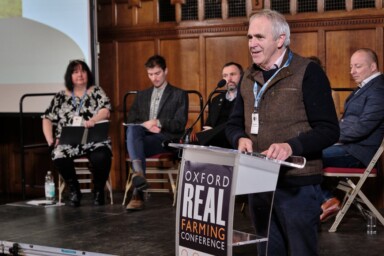5.30am: a cup of tea, hastily drunk, then out into the pitch dark to load the trailer for the 15 mile trip to our nearest abattoir.
I keep around 140 native breed sheep, and with wool and conservation grazing as my main priorities, meat is a small part of what I do overall. I rarely take more than 20 a year to the abattoir and those go in groups of 4 to 6, with the meat coming back to me to be passed on to family, friends and local customers. I produce hogget rather than lamb, from sheep grazed on permanent pasture and rough browse (nettles, bramble, thistles and the like), and without the assistance of concentrates or regular medication. Hogget, in my opinion, is a better meat: leaner with a depth of flavour and nutrients built slowly through one spring to the next and on into summer, with all the varied weather and vegetation that entails. It also means that I am not sending sheep to the abattoir before they are sheared, and in doing so wasting a product that should again be coming to the fore, helping to break our dependence on micro-fibre shedding synthetics.
Although I only deal in small numbers, the sale of hogget is an integral part of my whole farming system and, as such, is carefully managed for quality, animal welfare and sustainable practice.
In 2018, I wrote an article that started in a similar vein to this one and the loading and unloading of sheep in the early morning hasn’t changed. Then, however, the distance to my nearest abattoir was 3 miles and on arrival, I found myself among friends.
Last year the Pearce family of Chew Magna closed the small abattoir that I used, which they had operated for generations beside their butcher’s shop on the High Street.
“It wasn’t an easy decision,” Mark Pearce told me, before going on to explain the combination of factors that led to that decision being made.
Mark’s father, Clifford, had been the driving force behind the successful running of an abattoir that had provided a service for many local farming families, for many years. A period of ill health had sapped his strength and resulted in a temporary closure. The closure became permanent once all the other difficulties had been considered. “We used to be able to knock a bit off the price for our customers by doing it ourselves,” Mark said, “but now just running the big freezer is too much of an expense. Without the abattoir, we can manage with just the smaller freezer.”
Then, there are the staffing problems. What was once considered a skilled profession for a rural school-leaver, is no longer an occupation of choice. Villages previously populated by largely self-sufficient, stable communities have been bought out by a more transient population of commuters and second-home owners. This has significantly impacted the opportunity for young people to live and work in the place of their birth and reduces the chances of anyone staying around long enough to learn the trade. Couple this with an education system that only values advanced academic qualifications, and the links in the chains that are essential to local food production start to break.
We are lucky to have another abattoir within a reasonable distance and also that we can be sure it is well run and unlikely to close, given that it belongs to the University of Bristol vet school at Langford.
However, along with an extra 24 miles round trip, there are a number of disadvantages when compared to Pearce’s. Firstly, with no butcher at Langford, the carcases have to be transported back to Chew Magna for cutting, and in doing so the cost is increased. With small profit margins all additional costs are significant.
Although not large, the atmosphere at Langford is different to the very small family run abattoir we had become used to, where the pens are more farmyard than factory and you always meet someone you know. The village abattoir, like many other fast disappearing aspects of rural life, felt like its purpose was to provide a service to the local community. Given its scale and location in the centre of the village, it had a transparency about it that made many of the current rules and regulations seem somewhat superfluous. In short, there was nothing to hide, and the relaxed atmosphere made what could be a difficult job less stressful for both the farmers and the animals.
Langford, undoubtedly, has nothing to hide either. But it is tucked away out of sight of the public; the farmers queue in their vehicles, there is little opportunity to pass the time of day and, with people coming from increasing distances, it is unlikely that you will meet a neighbour.
All livestock that enters an abattoir in the UK is inspected by a qualified vet, provided by the company Eville and Jones on behalf of the Food Standards Agency. If you arrive when the inspector is there, the anxiety is palpable. It’s an anxiety that spreads, and I believe it is inevitable that the animals will also sense it and become anxious themselves. This seems somewhat ironic if animal welfare is part of the purpose of the inspection.
So why, in an abattoir with nothing to hide, would the presence of an inspector create anxiety? I suppose it is human nature to not like someone looking over your shoulder to find fault with what you do. If what you do is something you have done proficiently for many years, you are likely to become resentful of criticism from someone with less experience than you. And criticism seems to be the main objective of the inspector – something that is almost inevitable given the circumstances of their appointment.
The job of the vet is to check the health of the animal prior to slaughter, the practice of the abattoir, before, during and after slaughter and the condition of the carcase. Theoretically this should be a good thing. In practice, the inspectors are not receiving a salary that could be expected by a vet in practice and are made to feel they need to earn their pay. If they continually find no fault in the abattoir, it raises questions about their value for money. Given the shortage of qualified vets both in and out of the abattoir sector, you could argue that questions should be raised about the best use of a vet anyway, and whether there is not a more suitable approach to policing conduct in the abattoirs.
As independent abattoirs continue to close, citing staff shortages, costs and inspector-related difficulties, the choices for both farmer and consumer become increasingly limited. Last month the Isle of Mull’s abattoir closed, having failed to find suitable staff despite the offer of a £38,000 salary and local accommodation. It has left 230 farmers and crofters with long, complicated journeys to other abattoirs. This follows the closure in September of Mettrick’s of Glossop, an abattoir run by five generations of the same family for over 100 years, with 200 farmers and smallholders on their books.
The production of food should not be treated as an industrial process. The further people get from the source of their food, the less they will know or care about what has gone into producing it. They will know less about its nutritional value and less about its environmental impact. Meat, like much of our food these days, is largely produced on an industrial scale, with regulations and inspections originally devised for huge anonymous premises, also being inappropriately applied to the remaining small, localised services. At a time when over processed, over packaged, nutritionally depleted products increasingly pass as food, there seems to be little consumer understanding and no political will to save what is left of our diverse, small scale regional meat producers who depend on small local abattoirs.
At a time when health and environmental crises make the need to re-localise our food more critical than ever before, it seems we are still going in the wrong direction. How and when will we change it? That is the leading question.







